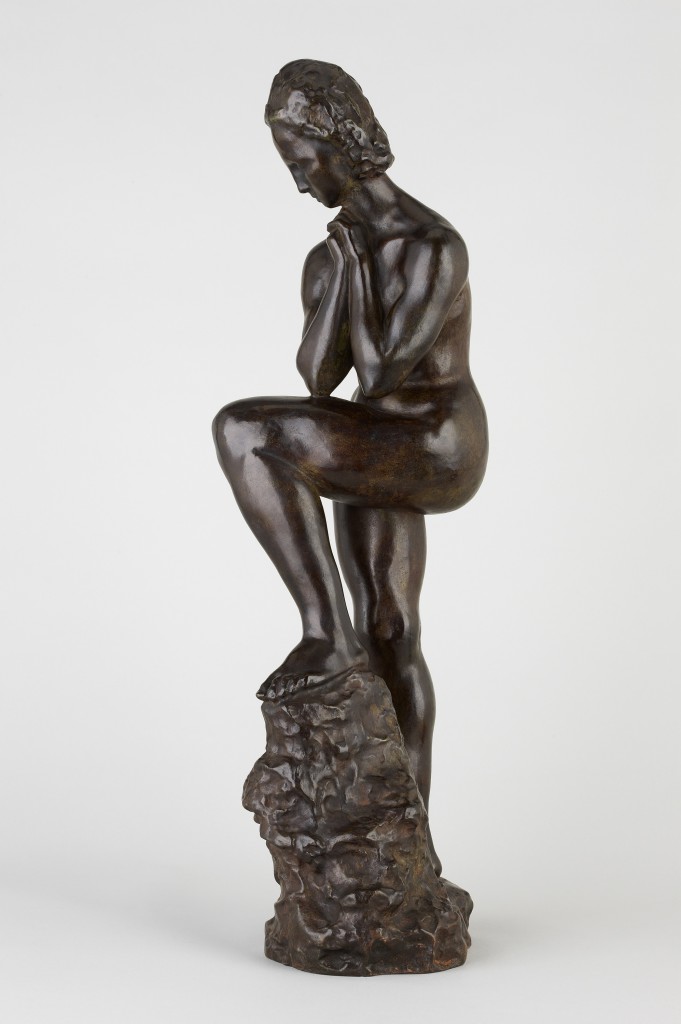Wilhelm Lehmbruck (Meiderich nr. Duisburg 1881 - 1919 Berlin)
Girl with one Foot Resting on a Rock, Paris, 1910
Lifetime cast
Bronze with brown patina, Height: 62.5 cm
Signed Lehmbruck/Paris beneath the right foot and inscribed A. Rudier Fondeur. Paris on the base
SOLD
Provenance:
Galerie Alex Vömel, Düsseldorf 1953
Walter Stein, Long Island, New York
The Walter and Sonja Caron Stein Collection, Long Island, New York
Literature:
Dietrich Schubert, Wilhelm Lehmbruck - Catalogue raisonné der Skulpturen, 1898-1919, Worms 2001, p.206 (two other lifetime casts illustrated, nos. 152 and 153)
Professor Dr. Dietrich Schubert has examined the work and confirmed its authenticity. His statement, dated 'July 2010, Heidelberg', accompanies the sculpture.
Professor Schubert states that the sculpture is [...] one of only very few lifetime casts of the figure made in Paris before 1914. Before the discovery of the present sculpture, only two lifetime casts of the figure were recorded. This third cast will be listed in the catalogue raisonné of Lehmbruck's sculptures.
The motif of a female bather with one foot resting on a stone or rock is a subject that has preoccupied artists since antiquity. The Renaissance saw a revival of interest in the subject - one example is Giambologna's Bathing Venus. The motif was taken up by nineteenth-century artists like Max Klinger, Louis Tuaillon and Aristide Maillol. Lehmbruck is known to have greatly admired Maillol's work. The present figure was executed in Lehmbruck's Parisian period between 1910 and 1914. It exemplifies how his preoccupation with the classical tradition and classical ideals led him to develop his own highly original style of sculptural expression. A number of preliminary drawings (Munich, Graphische Sammlung; Duisburg LN 117, 123) dating from the same period show him experimenting with the motif. A further group of drawings dating from this period depict a male figure in a similar position. Although the male figure is interpretable as a pendant Lehmbruck did not execute a sculpture of the subject.
The present sculpture is a lifetime cast executed in Paris under the artist's supervision. It has none of the deficiencies in quality common to the posthumous, unauthorized casts[1] of the figure. It bears the inscription A. Rudier, the inscription of the famous Parisian foundry Rudier established by Alexis Rudier (d.1897). Rudier's son Eugène (1875-1952) later took over the business, building it up to become one of the leading foundries of its day. It produced casts for Auguste Rodin, Aristide Maillol and Antoine Bourdelle and was also involved in casting some of the outstanding bronzes of the late nineteenth and early twentieth centuries. Like Rodin, Maillol and Bourdelle, Lehmbruck would almost certainly have supervised the casting of the present sculpture himself and had a hand in the working up of its marvellously rich patina.
[1] It is not just the overall quality of the cast, the quality of its surface and the richness of its patina that distinguish the present figure from later casts. The distance between the right heel and the ground - only 4.1 cm - is a further distinguishing feature. This distance is shorter than in the innumerable posthumous casts of the figure. It is identical to the relevant measurement in the case of the two lifetime casts recorded in the catalogue raisonné. See Dietrich Schubert, Wilhelm Lehmbruck: Catalogue raisonné der Skulpturen, 1898-1919, Worms 2001, no. 54. B. a.1 and 2. Both are A. Rudier casts. Professor Schubert, the author of the catalogue raisonné, has set stringent standards for meeting his authenticity criteria. His objective is to limit Lehmbruck's sculptural oeuvre to a core body of work and exclude the large number of new casts made over a period of decades after his death. Following Lehmbruck's suicide in 1919, his widow had new casts made right through to the 1940s. Lehmbruck's sons continued to commission casts from the 1950s to the 1970s. Unauthorized casts of Girl with one Foot Resting on a Rock have also come onto the art market. Some of these casts are stamped with the foundry mark H. Gonot/Paris while others are unmarked. These casts are of poor quality and often smaller in format. In many cases the figure itself has been cast separately and a plinth added. In the case of forged casts, about two centimetres have been found to have been added to the lower edge of the model/bronze to obtain the standard height of 63/64 cm compensating for the loss of height in casting a sculpture from a negative matrix.

